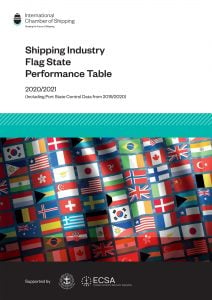Shipping Industry Flag State Performance Table 2020/2021
This edition has been withdrawn and replaced by the 2021/2022 edition.

The Shipping Industry Flag State Performance Table brings together data regarding the performance of flag States against specific criteria, including Port State Control (PSC) records, ratification of international conventions and IMO meeting attendance. The 2020/2021 edition is based on the most up-to-date data available as of January 2021.
It is intended to encourage shipowners to maintain a dialogue with their flag administrations, and help facilitate necessary improvements in the interests of safety, the environment and decent working conditions.
COVID-19
Due to the unprecedented nature of the COVID-19 outbreak, the 2019/2020 Flag State Performance Table was not published. In order to maintain a complete and accurate record of PSC performance of flag States in 2019, alongside this year’s table (2020/2021), ICS has published the relevant PSC data on the last page, corresponding to information released in 2019 by the Paris MOU, the Tokyo MOU and the United States Coast Guard (USCG) in their respective annual PSC reports.
Flag State performance in 2021
The level of performance of many of the largest flag States – including Marshall Islands, Hong Kong, Singapore as well as the Bahamas and Cyprus – continues to be very positive.
The table clearly indicates that distinctions between ‘traditional’ flags and open registers are no longer meaningful, with many open registers among the very top performers alongside several European registers, and flags such as Japan, which are all expected to perform well.
Among the ten largest ships registers (by dead weight tonnage), covering more than 70% of the world fleet, none have more than two indicators of potentially negative performance, and five have no negative indicators at all.
Nevertheless, a number of smaller flag States still have a lot of work to do to address indicators of potential negative performance, and shipowners should consider very carefully the prospect of using these flags, which may be perceived to be sub-standard, according to the data on the table.
Updates to criteria
The criteria of the table are constantly under review. In response to recent feedback received from governments and industry, we have implemented a number of updates to some of the criteria, to ensure that the table remains as objective as possible and fit for purpose, for industry and regulators alike.
This includes an update to the table’s Recognised Organisations (RO) criteria, used to determine if ROs conducting survey work on behalf of a particular flag State are viewed as being capable of doing so in accordance with the IMO RO Code.
This year, ICS used a new calculation methodology for this existing criterion, whereby flag States are now indicated positively if a) ≥50% of ROs they employ are listed as ‘high-performing’ in either the Paris MOU or Tokyo MOU ‘Performance of Recognized Organisations’ lists and b) flag States have submitted the relevant RO data in line with the RO Code.
Explaining the performance indicators
Given the nature of the performance indicators used by ICS, whether or not a flag State is missing one or two green squares on the table should not be viewed as a serious concern. As such, a flag with a solid row of ‘green squares’ should not necessarily be viewed as superior to another that is missing one or two ‘green squares’, for which there may be good reason.
For example, a flag State may not have ratified a particular IMO or ILO instrument due to a conflict with its national law while nevertheless implementing the Convention’s main requirements.
Another example of a good reason for why a flag may be lacking one or two positive indicators could apply to PSC, especially if it has had too few port calls to gain a place in the ‘white lists’ of certain PSC regimes.
The above notwithstanding, if a State is lacking a large number of positive indicators then shipowners may want to ask serious questions.
Related content

Shipping Industry Flag State Performance Table 2023/2024

Shipping Industry Flag State Performance Table 2022/2023

LEG 111-4(a)-2 – (a) Provision of financial security in case of abandonment of seafarers, and shipowners’ responsibilities in respect of contractual claims for personal injury to, or death of, seafarers, in light of the progress of amendments to the ILO Maritime Labour Convention, 2006 Comments on document LEG 111/4(a)
